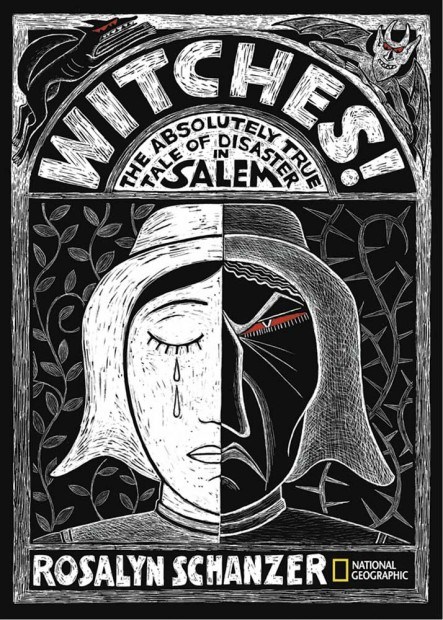You’ve been called worse. Last week, when you accidentally bumped into your school’s Mean Girl, she was mad. You apologized, but she gave you one of those looks that makes you feel small, and she called you a “little witch.”
You’ve been called worse.
Last week, when you accidentally bumped into your school’s Mean Girl, she was mad. You apologized, but she gave you one of those looks that makes you feel small, and she called you a “little witch.”
Okay. So you’ve been called worse. And it was funny that those words came from the Queen Witch’s mouth. Takes one to know one.
But if you’d lived over 300 years ago, you wouldn’t have been able to shrug off those words. As you’ll see in “Witches! The Absolutely True Tale of Disaster in Salem” by Rosalyn Schanzer, you might have been fighting for your life.
Reverend Samuel Parris had a lot on his mind.
It was cold in Salem, Massachusetts that January, 1692, and the firewood that the villagers promised him never arrived. Neither did the money they said he’d get, and Parris was getting concerned. What bothered him most, though, was that his nine-year-old daughter, Betty, and her eleven-year-old cousin, Abigail, were ailing.
Both girls suffered from episodes that found them flailing about on the floor, twitching and choking and speaking gibberish, frightening the other members of the household. Everyone was terrified, then, when a local doctor declared that the girls were under the influence of witchcraft.
Shrieking as if in great pain, the girls accused the Reverend’s female house slave of witchcraft. Then they accused a beggarwoman and a bedridden farm wife. The three women were arrested, but not before other girls came forth with screams and accusations. Soon, several other people were pointing fingers at innocent neighbors with accusations of their own.
Four months later, Royal Governor of Massachusetts William Phips came home from London to a mess. Quickly realizing that things were out of hand, he appointed judges to determine the fate of so-called “witches” in Salem, but that didn’t end the frenzy: on June 10, tavernkeeper Bridget Bishop became the first person to hang as a witch.
So what caused the panic and hysteria that ended in the deaths of 20 people? No one knows for sure but it’s possible that a book was at fault, even though its author was against all that happened that year in Salem.
So could it happen again? Author Rosalyn Schanzer leaves that tantalizing question for her young readers to answer, after she scares the daylights out of them.
“Witches!” is a fresh look at the story we’ve all heard before, along with some fantastic artwork done by the author.
But then we get details that don’t come with the history books.
In Schanzer’s hands, a thrice-married barmaid, a sweet grandmother, and a sparky toddler all become genuine people. We quickly identify with them and come to like them, which makes for a harsher inevitability that may upset more sensitive readers. And for that, I don’t think I can recommend this book for kids under 12.
For teens, though, this book is just gruesome enough to please and real enough to resonate. Give your 13-to-17-year-old “Witches!”, in fact, and they’ll be spellbound.
• The Bookworm is Terri Schlichenmeyer. Terri has been reading since she was 3 years old and she never goes anywhere without a book.


